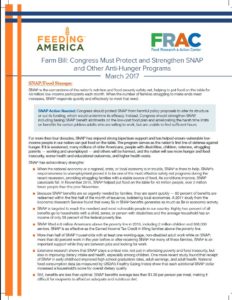Farm Bill Basics
The farm bill is a fairly comprehensive, multiyear piece of legislation that governs a substantial array of federal farm, food, fiber, forestry, and rural policies and programs under the joint jurisdiction of the House Committee on Agriculture and the Senate Committees on Agriculture, Nutrition, and Forestry. The comprehensive omnibus bill is passed every 5 years or so by the United States Congress and deals with both agriculture and all other affairs under the purview of the United States Department of Agriculture. From the beginning, but growing in importance in the past five decades, the farm bill has also been the controlling legislation for a variety of federal nutrition programs, most importantly the food stamp program, today know as the Supplemental Nutrition Assistance Program (SNAP).
About the Supplemental Nutrition Assistance Program (SNAP)
SNAP offers nutrition assistance to millions of eligible, low-income individuals and families and provides economic benefits to communities. SNAP is the largest program in the domestic hunger safety net. SNAP is the largest nutrition assistance program administered by the U.S. Department of Agriculture. SNAP was previously named the Food Stamp Program until Oct. 1, 2008. Every five years, SNAP is reauthorized by Congress as part of the Farm Bill. The reauthorization establishes who is eligible for SNAP and addresses program access, benefit levels, and other matters. In 2015 SNAP helped lift 4.6 million Americans out of poverty.
The Food and Nutrition Service works with State agencies, nutrition educators, and neighborhood and faith-based organizations to ensure that those eligible for nutrition assistance can make informed decisions about applying for the program and can access benefits. The U.S. Congress sets the food stamps benefit amount at, on average, roughly $4 a day per person and 83% of all SNAP/food stamp benefits go to households with a child, senior, or disabled person. Most food stamp recipients are children and the elderly.
Legislators at both the federal and state level – typically self-described conservatives – regularly try to place limits on the Supplemental Nutrition Assistance Program (SNAP, or “food stamps”). In recent years, they have tried to cut food stamp funding at every opportunity. They propose rules to humiliate and demonize recipients of food stamps and other welfare programs, which they claim create a “culture of dependency. BUT the truth about SNAP is:
- Each dollar spent in food stamp benefits generates nearly double that in local economic activity.
- To qualify, recipients’ households need to earn at or below 130% of the poverty line—or about $26,000 or less a year for a family of three
- More than half of SNAP households with at least one working-age, non-disabled adult work while on SNAP; more than 80% work in the year before or after receiving SNAP. For many of these families, SNAP is an important support while they are between jobs and looking for work

READ THIS: Farm Bill: Congress Must Protect and Strengthen SNAP and Other Anti-Hunger Programs
LEARN MORE: Building a Healthy America: A Profile of the Supplemental Nutrition Assistance Program
ACTIVATE:
Stay tuned for Action Alerts as Farm Bill advocacy should be ramping up soon. In the meantime, Hunger Action Network will focus on the following points:
- Congress should protect SNAP from harmful policy proposals to alter its structure or cut its funding, which would undermine its efficacy. Instead, Congress should strengthen SNAP, including basing SNAP benefit allotments on the low-cost food plan and ameliorating the harsh time limits on benefits for certain jobless adults who are willing to work, but are unable to find sufficient hours.
- Keeping SNAP in the Farm Bill, some in the House are advocating to remove SNAP from the Farm Bill and converting it to a block grant, which would allocate its administration to the states. HANNYS believes that block-granting the program would result in cuts, as the program would have less ability to respond to emergency situations.
